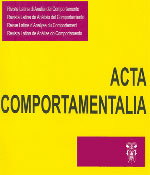Visual primacy II: Transfer under changes of stimulus modality and linguistic mode
Main Article Content
Abstract
Ninety subjects with different school grades were trained on a zero-delay, second-order matching-to-sample task. The task consisted in the class identification of objects, animals or vegetables. Stimuli could be visual (V), auditory (A), or both in one of six possible arrays of second-order, sample, and comparison stimuli. The transfer tests changed the stimulus modality. If training included visual stimulus, the transfer test presented it in auditory modality, and vice versa. Transfer sessions involved test trials (1) with the same number, (2) fewer, or (3) more auditory stimuli than training. Three of the second-grade, 10 of the fifth-grade and 11 of ninth-grade subjects could learn the task and performed well on transfer trials when these included more visual than auditive stimuli. In any condition college students performed well during training and testing. Physical trainers’ performance was similar to that of ninth grade subjects. This study points to the primacy of visual stimulation and the importance of stimulus modality in this kind of task.
Article Details
Citas en Dimensions Service

<a rel="license" href="http://creativecommons.org/licenses/by-nc-sa/4.0/"><img alt="Licencia de Creative Commons" style="border-width:0" src="https://i.creativecommons.org/l/by-nc-sa/4.0/88x31.png" /></a><br />Este obra está bajo una <a rel="license" href="http://creativecommons.org/licenses/by-nc-sa/4.0/">licencia de Creative Commons Reconocimiento-NoComercial-CompartirIgual 4.0 Internacional</a>.


